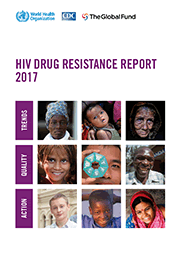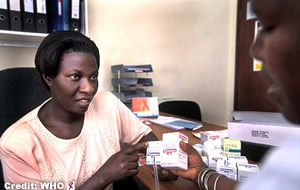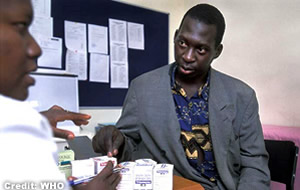 |
Gesundheit AIDS-HIV |
 |
Gesundheit Weitere Informationen |
|
|
Resistenz gegen Wirkstoffe in HIV-Medikamenten |
 |
|
| Die Weltgesundheitsorganisation WHO warnt in ihrem Bericht «WHO HIV drug resistance report 2017» vor der zunehmenden Resistenz von HI-Viren gegenüber den während der HIV-Therapien verwendeten Medikamenten. Untersuchungen der WHO haben ergeben, dass in 6 der 11 erforschten Ländern in Afrika, Asien und Südamerika (Kamerun, Namibia, Uganda, Simbabwe, Guatemala, Mexico, Nicaragua, Argentinien, Brasilien, Kolumbien und Myanmar) bei mehr als 10% der Personen, welche in eine HIV-Therapie eintreten wollten, bereits resistente Viren entdeckt wurden. Die Gefahr wächst, dass diese Patientengruppe die resistenten Viren auf anderen Personen übertragen. Gleichzeitig erhöht sich der Prozentsatz der noch nicht mutierten HI-Viren in ihrem Blut. |
|
Die Erfolgsaussichten der antiretroviralen Therapien werden durch diese Entwicklung vermindert. Die WHO rät deshalb jenen Ländern, in welchen über 10% der Therapiekandidaten über resistente HI-Viren verfügen, die nationalen HIV-Behandlungsprogramme zu überprüfen. Eine Änderung der Programme ist mit steigenden Kosten verbunden.
Der Anstieg der resistenten HI-Viren führt zu mehr Infektionen und zu einer grösseren Anzahl von Todesopfern. Modellrechnungen der WHO zeigen, dass in den nächsten 5 Jahren ohne erfolgreiche Gegenmassnahmen zusätzlich 105'000 Neuinfektionen und 135'00 Todesopfer zu erwarten sind. Im gleichen Zeitraum werden die Kosten für die HIV-Behandlungsprogramme um rund 659 Millionen USD ansteigen. Die zunehmende Medikamentenresistenz gefährdet die UN-Entwicklungsziele «Ziele einer nachhaltigen Entwicklung der UNO 2015-2030» (Sustainable Development Goals 2030).
Die Resistenz (= HIV-Medikamentenresistenz HIVDR) von Medikamenten (= antiretrovirale Medikamente ARV), welche bei einer HIV-Therapie (= Antiretrovirale Therapie ART) gegen das HI-Virus eingesetzt werden, wird durch eine Veränderung der genetischen Struktur der HI-Viren verursacht.
Die während einer Therapie eingesetzten Medikamente (odereiner Kombination von Medikamenten) verhindern, dass sich die Viren reproduzieren und somit vermehren können. Bei allen gegenwärtig eingesetzten älteren und auch neueren ARV-Medikamenten besteht die Gefahr, dass sie wegen der Ausbreitung von resistenten HI-Virusgenerationen ihr Wirksamkeit verlieren.
Die Resistenz von HIV-Medikamenten kann auf drei Wegen entstehen:

| 1. |
Bei Einzelpersonen, welche mit ART-Medikamenten behandelt werden, können bei der Reproduktion der HI-Viren genetischen veränderte Mutationsformen entstehen. |
| 2. |
Die durch eine Übertragung erworbene HIV-Medikamentenresistenz (= Transmitted HIV drug resistance TDR) tritt auf, wenn zuvor nicht infizierte Einzelpersonen, welche sich noch keiner Therapie unterzogen hatten, sich mit mutierten, Medikamenten resistenten Viren infiziert haben. |
| 3. |
Vor der Therapie erworbene Medikamentenresistenz PDR (= Pre-treatment HIV drug resistance): |
 |
Medikamenten resistente HI-Viren können auch bei Personen auftreten, welche sich zuvor noch keiner ART unterzogen haben. Auch können Personen, welche bereits zu einem früheren Zeitpunkt mit ARV-Medikamenten versorgt wurden (beispielsweise Frauen, welche vor einer Geburt ARV-Medikamente eingenommen haben, um eine Virenübertragung auf das Kind zu verhindern) mit resistenten Viren infiziert sein. Bei dieser Ausgangslage wird eine erneute Therapie (Zweittherapie) wesentlich erschwert. Die HIV-positiven Patienten können die resistenten Viren bereits bei der Erstinfektion erhalten haben, oder diese haben sich erst zu einem späteren Zeitpunkt aus einer Mutation entwickelt. |
|
 |
 |
 |

| AIDS |
Acquired ImmunoDeficiency Syndrome |
ADR |
Acquired HIV drug resistance |
| AMR |
Antimicrobial resistance |
| ART |
Antiretroviral therapy |
| ARV |
Antiretroviral (drugs) |
| HIV |
Human Immunodeficiency Virus |
| HIVDR |
HIV drug resistance |
| PDR |
Pre-treatment HIV drug resistance |
| TDR |
Transmitted HIV drug resistance |
|
 |

| ARV drug-naive people |
«ARV drug-naive people»sind Menschen, welche niemals gegen eine bestimmte Krankheit mit Medikamenten behandelt wurden. Der Ausdruck wird bei sexuell übertragbaren Infektionskrankheiten für HIV-positive Personen verwendet, welche welche zuvor noch nie während einer Therapie (ART) mit ARV-Medikamenten behandelt wurden. |
| Pre-treatment HIV drug resistance |
Weltweit werden immer mehr HIV-positive Personen während einer Therapiemit ARV-Medikamenten versorgt.Durch diegrössere Anzahl der therapierten HIV-Patienten treten in neuster Zeit vor allem in Afrika Fälle («Pre-treatment HIV drug resistance») auf, wo Personen vor der ersten Behandlung mit ARV-Medikamenten bereits HIVDR-Viren in sich tragen. Auch bei Personen, welche sich bereits einer ersten ART-Behandlung unterzogen haben, werden zunehmend HIVDR-Viren identifiziert. Die beiden Entwicklungen führen dazu, dass bei einer immer grösseren Anzahl von Menschen eine zweite ART-Behandlung angeordnet werden muss. Die Gesundheitsbehörden der von dieser Entwicklung betroffenen Länder müssen daher in den kommenden Jahren mit zunehmenden Kosten rechnen. |
| Retroviren |
Retroviren
werden als Sonderform der RNA-Viren betrachtet. Als RNA-Viren bezeichnet man eine heterogene
Gruppe von Viren, die als gemeinsames Strukturelement ein RNA-Genom aufweisen. |
| Antiretroviral |
Antiretroviral bedeutet "gegen ein Retrovirus gerichtet" oder "wirksam gegen Retroviren". |
| HIV |
 |
 |
 |
|
 |
 |
 |
| Quelle: WHO , WHO Department of HIV, Global Hepatitis Programme, WHO HIV drug resistance report 2017 , Juli 2017 |
| Text: RAOnline |
nach oben
| WHO urges action against HIV drug resistance threat |
 |
The WHO HIV drug resistance report 2017 shows that in 6 of the 11 countries surveyed in Africa, Asia and Latin America, over 10% of people starting antiretroviral therapy had a strain of HIV that was resistant to some of the most widely used HIV medicines. Once the threshold of 10% has been reached, WHO recommends those countries urgently review their HIV treatment programmes.
HIV drug resistance report 2017
"Antimicrobial drug resistance is a growing challenge to global health and sustainable development," said Dr Tedros Adhanom Ghebreyesus, WHO Director-General. "We need to proactively address the rising levels of resistance to HIV drugs if we are to achieve the global target of ending AIDS by 2030."
HIV drug resistance develops when people do not adhere to a prescribed treatment plan, often because they do not have consistent access to quality HIV treatment and care. Individuals with HIV drug resistance will start to fail therapy and may also transmit drug-resistant viruses to others. The level of HIV in their blood will increase, unless they change to a different treatment regimen, which could be more expensive - and, in many countries, still harder to obtain.
Of the 36.7 million people living with HIV worldwide, 19.5 million people were accessing antiretroviral therapy in 2016. The majority of these people are doing well, with treatment proving highly effective in suppressing the HIV virus. But a growing number are experiencing the consequences of drug resistance.
WHO is therefore issuing new guidelines to help countries address HIV drug resistance. These recommend that countries monitor the quality of their treatment programmes and take action as soon as treatment failure is detected.
"We need to ensure that people who start treatment can stay on effective treatment, to prevent the emergence of HIV drug resistance," said Dr Gottfried Hirnschall, Director of WHO's HIV Department and Global Hepatitis Programme. "When levels of HIV drug resistance become high we recommend that countries shift to an alternative first-line therapy for those who are starting treatment."
Increasing HIV drug resistance trends could lead to more infections and deaths. Mathematical modelling shows an additional 135 000 deaths and 105 000 new infections could follow in the next five years if no action is taken, and HIV treatment costs could increase by an additional US$ 650 million during this time.
Tackling HIV drug resistance will require the active involvement of a broad range of partners. A new five-year Global Action Plan calls on all countries and partners to join efforts to prevent, monitor and respond to HIV drug resistance and to protect the ongoing progress towards the Sustainable Development Goal of ending the AIDS epidemic by 2030. In addition, WHO has developed new tools to help countries monitor HIV drug resistance, improve the quality of treatment programmes and transition to new HIV treatments, if needed.
The WHO HIV drug resistance report 2017 was co-authored by the Global Fund to Fight AIDS, Tuberculosis and Malaria, and the Centers for Disease Control and Prevention, USA.
"This new report shows a worrying picture of increasing levels of HIV drug resistance and, if unchecked, it will be a major risk to program impact," said Dr Marijke Wijnroks, Interim Executive Director of the Global Fund. "We strongly recommend implementing WHO recommendations for early warning indicators and HIV drug resistance surveys in every national plan for antiretroviral therapy, and to consider funding them through Global Fund grants or reprogramming."
Dr Shannon Hader, Director of CDC's Division of Global HIV and Tuberculosis, US Centers for Disease Control and Prevention, added: "The new report pulls together key HIV drug resistance survey findings from across the globe that, taken together with other national-level data, confirm we must be forward-thinking in our efforts to combat resistance: scaling up viral load testing, improving the quality of treatment programs, and transitioning to new drugs like dolutegravir."
Dr. Hader continued, stating that "Overall high rates of viral suppression across three recent national Population-based HIV Impact Assessments showed that present first-line regimens remain largely effective. However, special attention to populations at risk for higher resistance, such as pediatrics, adolescents, pregnant women and key populations, will be critical to target more urgent interventions. We call on the global community for continued vigilance and responsiveness."
9th IAS Conference on HIV Science
In addition to the Report, Guidelines and the Global action plan on HIV drug resistance, WHO is releasing seven key guidelines and normative tools at the 9th International AIDS Society Conference on HIV Science IAS2017, as follows:
● A new information note on point-of-care early infant diagnosis assays to support the timely detection of children with HIV.
● The results of "STAR-self-testing in Africa" an implementation research effort, together with a new landscape report on rapid diagnostic tests for HIV self-testing.
● A prioritized research agenda for children and adolescents to address low treatment scale-up and quality care for this group.
● New guidelines on advanced HIV disease and rapid initiation of ART recommending screening, treatment and prophylaxis for major opportunistic infections (such as tuberculosis and cryptococcal disease), and rapid initiation of ART and adherence support for people with advanced HIV.
● A new report outlining how countries can provide differentiated care tailored services for different needs of patient groups.
● A new technical update advising countries on what to consider when transitioning to a new treatment regimen, including dolutegravir.
● An announcement on the findings from INSPIRE, a WHO / Government of Canada collaboration on implementation research which investigates how to ensure mothers return for continuation of care.
 |
| HIV drug resistance report 2017 |
Authors:
World Health Organization, United States Centers for Disease Control and Prevention, The Global Fund to Fight AIDS, Tuberculosis and Malaria |
| Number of pages: 82 |
| Publication date: July 2017 |
| Languages: English |
| WHO reference number: 978-92-4-151283-1 |
|
Downloads
http://www.unaids.org
HIV drug resistance report 2017
pdf, 5 MB
Access guidelines
Access Global Action Plan
Access policy brief: Tackling HIV drug resistance: trends, guidelines and global action |
Overview
This second HIVDR report provides an update on recent population levels of HIVDR covering the period 2014-2016. The report includes data from 16 nationally representative surveys from 14 countries estimating resistance in: adults initiating ART (PDR), children younger than 18 months newly diagnosed with HIV, and adults on ART (acquired HIV drug resistance or ADR).
To contextualize results from representative HIVDR surveys, the report is supported by systematic reviews of the published literature on PDR in adults, children and adolescents, and ADR in paediatric and adult populations.
Finally, the report includes the prevalence of transmitted HIV drug resistance (TDR) in recently infected people in Malawi and Zimbabwe, estimated as part of recent household Population-based HIV Impact Assessment (PHIA) surveys, supported by the United States President's Emergency Plan for AIDS Relief (PEPFAR). |
 |
 |
| Source: Text WHO , WHO Department of HIV, Global Hepatitis Programme, WHO HIV drug resistance report 2017 , July 2017 |
nach
oben
| Reports on the global AIDS epidemic |
 |
 |
Externe Links |
|







